Welcome to the Dura Heat Kerosene Heater Manual, your comprehensive guide to safe and efficient operation. This manual provides essential instructions for installation, maintenance, and troubleshooting to ensure optimal performance and safety.
Overview of the Dura Heat Kerosene Heater
The Dura Heat Kerosene Heater is a portable, reliable heating solution designed for both indoor and outdoor use. With its robust construction and adjustable heat settings, it provides efficient warmth in various spaces. Its compact design makes it easy to move and position, while its fuel-efficient operation ensures long-lasting heat output. Safety features like automatic shut-off and a secure fuel tank add to its reliability. Ideal for emergencies, workshops, or large areas, this heater is a versatile choice for maintaining comfort during cold conditions. Always refer to the manual for proper usage and safety guidelines.
Importance of Following the Manual Instructions
Adhering to the Dura Heat Kerosene Heater Manual is crucial for safe and effective operation. Proper assembly, fueling, and maintenance ensure optimal performance and longevity. Ignoring instructions can lead to safety hazards, such as indoor air pollution or fire risks. The manual provides clear guidelines to avoid fuel contamination and improper usage, which can damage the heater or pose health risks. By following the instructions, users can prevent accidents, maintain efficiency, and extend the heater’s lifespan. Always prioritize safety and performance by strictly adhering to the manual’s recommendations.
Key Features of the Dura Heat Kerosene Heater
The Dura Heat Kerosene Heater offers portable, efficient heating solutions with advanced features. It includes a high BTU output, radiant heat technology, and adjustable wick control for customized warmth. Built with durable materials, it ensures long-lasting performance. Safety features like automatic shut-off and secure fuel tanks enhance user protection. The heater is designed for versatility, suitable for both indoor and outdoor use, with easy mobility and maintenance. Its compact design makes it ideal for various spaces, providing reliable heat while maintaining energy efficiency and operational safety.
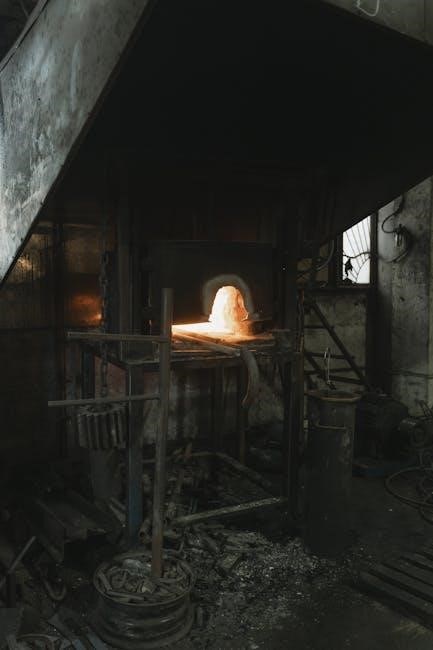
Safety Precautions and Warnings
Always follow the manual’s instructions to ensure safe operation. Use only 1-K kerosene or No. 1 fuel oil, and maintain proper ventilation to avoid hazards.
General Safety Guidelines
To ensure safe operation, always follow the manufacturer’s instructions. Use only 1-K kerosene or No. 1 fuel oil, as specified in the manual. Never use gasoline, benzene, or other unauthorized fuels, as this can cause serious hazards. Proper ventilation is essential to prevent indoor air pollution and carbon monoxide risks. Keep the heater away from flammable materials and out of reach of children and pets. Avoid operating the heater in poorly ventilated areas or near open windows. Regularly inspect the heater for damage or wear and address any issues promptly to maintain safety.
Warnings Against Improper Fuel Usage
Never use fuels such as gasoline, benzene, or paint thinner in your Dura Heat kerosene heater, as these can cause explosions or fires. Only use 1-K kerosene or No. 1 fuel oil, as specified in the manual. Using improper fuels can lead to serious safety hazards, including carbon monoxide poisoning and equipment damage. Always ensure the fuel is fresh and stored correctly, avoiding contamination. Improper fuel usage voids the warranty and poses significant risks to your safety and the heater’s performance; Always follow the manufacturer’s fuel recommendations to ensure safe and efficient operation.
Indoor Air Pollution Risks
Using a kerosene heater indoors can pose risks of air pollution if proper ventilation is not maintained. Inadequate ventilation may lead to the buildup of carbon monoxide, nitrogen dioxide, and other harmful fumes. Always ensure the heater is used in well-ventilated areas, with at least three square feet of ventilation. Never operate the heater in tightly sealed rooms, as this can result in dangerous indoor air quality. Prolonged exposure to these fumes can cause respiratory issues and other health hazards. Always follow the manual’s ventilation guidelines to minimize pollution risks and ensure a safe environment.
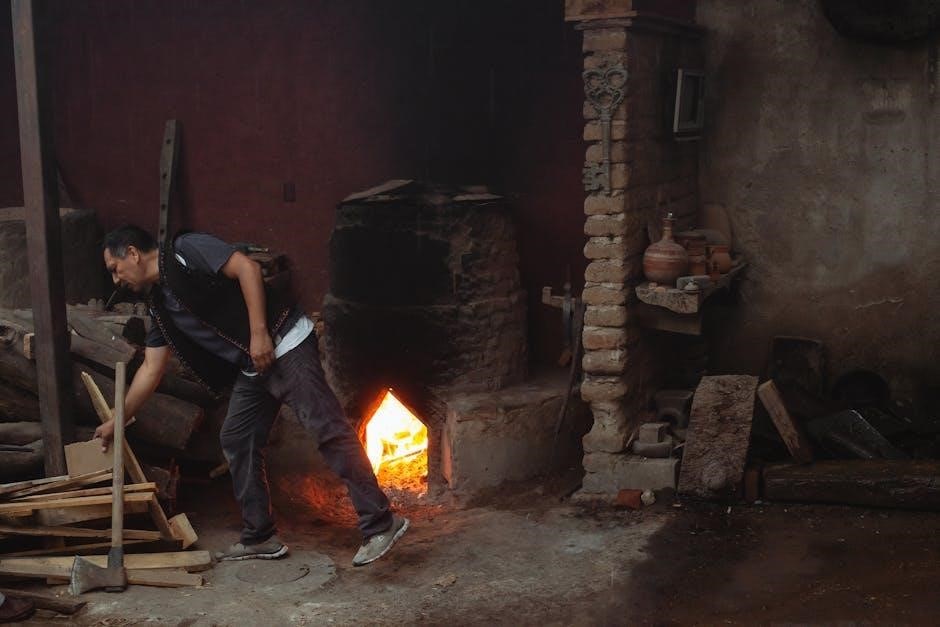
Proper Ventilation Requirements
Proper ventilation is crucial when operating a Dura Heat kerosene heater indoors. Ensure the heater is used in a well-ventilated area to prevent the accumulation of harmful fumes. Provide at least three square feet of ventilation, such as an open window or door, to maintain air quality. Never operate the heater in a tightly sealed room, as this can lead to carbon monoxide buildup. Always follow the ventilation guidelines outlined in the manual to ensure safe and efficient operation, minimizing the risks associated with indoor air contamination.

Model Specifications and Compatibility
The Dura Heat kerosene heater models, such as DFA50 and DFA135C, offer varying BTU outputs and coverage areas. They are compatible with 1-K kerosene and 1 fuel oil, ensuring safe operation.
Dura Heat Kerosene Heater Models
The Dura Heat kerosene heater lineup includes models such as the DFA50, DFA80T, DFA135C, and DFA180CV. These models are designed for portability and efficiency, offering varying BTU outputs to suit different spaces. The DFA50 provides reliable heat for smaller areas, while the DFA180CV is ideal for larger coverage. All models are CSA and UL certified, ensuring safety and performance. Manufactured by Dyna Glo in Korea, these heaters are part of the Dura Heat brand, known for durability and consistent heat output. Each model is compatible with 1-K kerosene and 1 fuel oil for optimal performance.
Heating Capacities and Coverage Areas
Dura Heat kerosene heaters are designed to provide efficient heating across various spaces. Models like the DFA50 offer coverage for smaller areas, while the DFA135C delivers 23,800 BTU, suitable for medium-sized spaces. The DFA180CV model, with its higher BTU output, can cover up to 1,000 square feet, making it ideal for larger areas. Each model is CSA and UL certified, ensuring safe and reliable performance; Whether for garages, workshops, or larger indoor spaces, Dura Heat heaters are built to deliver consistent warmth with minimal fuel consumption. Choose the right model to match your heating needs for optimal results.
Compatible Fuels for the Heater
The Dura Heat kerosene heater is specifically designed to operate with 1-K kerosene or No. 1 fuel oil. Using these fuels ensures optimal performance and safety. NEVER use gasoline, diesel, or other non-recommended fuels, as they can cause damage or pose serious safety risks. Always store kerosene properly and avoid using old or degraded fuel, as it may harm the heater. Refer to your manual for fuel storage guidelines to maintain efficiency and longevity of your Dura Heat heater.
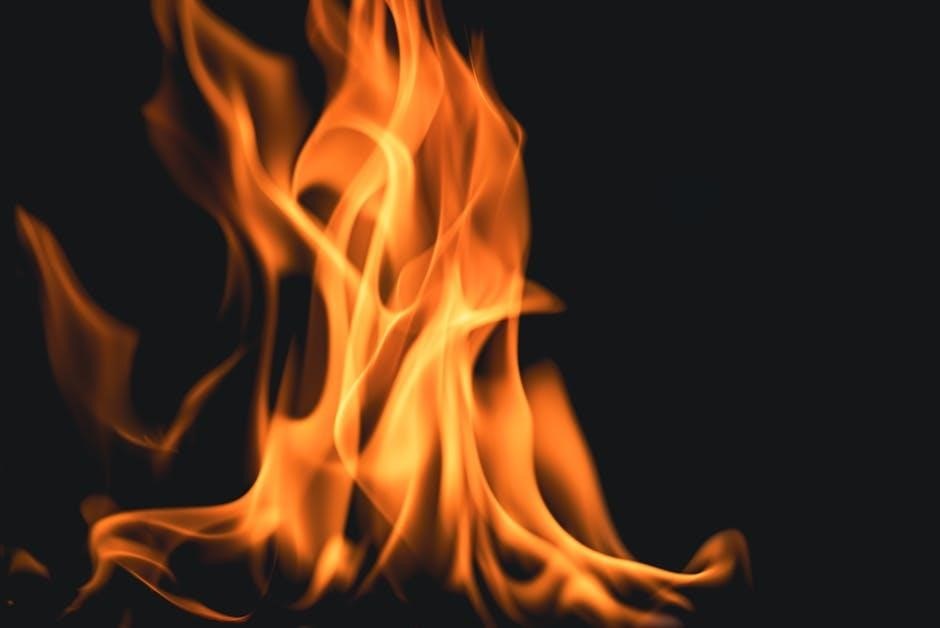
Installation and Assembly
Follow the manual carefully for proper assembly. Connect the fuel tank securely, attach the wick and burner, and ensure all components are correctly aligned for safe operation.
Step-by-Step Assembly Instructions
- Unpack the heater and ensure all components are included.
- Place the heater on a stable, level surface.
- Connect the fuel tank securely to the main unit.
- Attach the wick and burner assembly following the manual.
- Ensure proper alignment of all parts for safe operation.
- Before use, allow the wick to soak in kerosene for 30 minutes.
- Refer to the manual for specific assembly details and safety precautions.
Always use genuine Dura Heat replacement parts for optimal performance.
Connecting the Fuel Tank
Connecting the fuel tank to your Dura Heat kerosene heater is a straightforward process. Ensure the heater is turned off and cool before starting. Locate the fuel tank connector and align it with the heater’s fuel inlet. Gently push the connector into the inlet until it clicks securely. Tighten the connector by hand to avoid over-tightening. Use only 1-K kerosene or No. 1 fuel oil for optimal performance. Never use gasoline or other flammable liquids. After connecting, check for leaks by applying soapy water to the connection points. If bubbles form, tighten the connection. Always follow the manual for specific guidelines.
Attaching the Wick and Burner
To attach the wick and burner, start by removing the old wick assembly if replacing. Gently pull the wick upward while twisting it counterclockwise; Insert the new wick into the burner housing, aligning the tabs. Push down firmly and twist clockwise until it clicks. Ensure the wick is evenly seated and the burner is securely attached. Use only genuine replacement wicks to maintain efficiency. Refer to the manual for specific alignment instructions. Proper installation ensures safe and optimal heat output. Always follow safety guidelines to avoid damage or hazards.
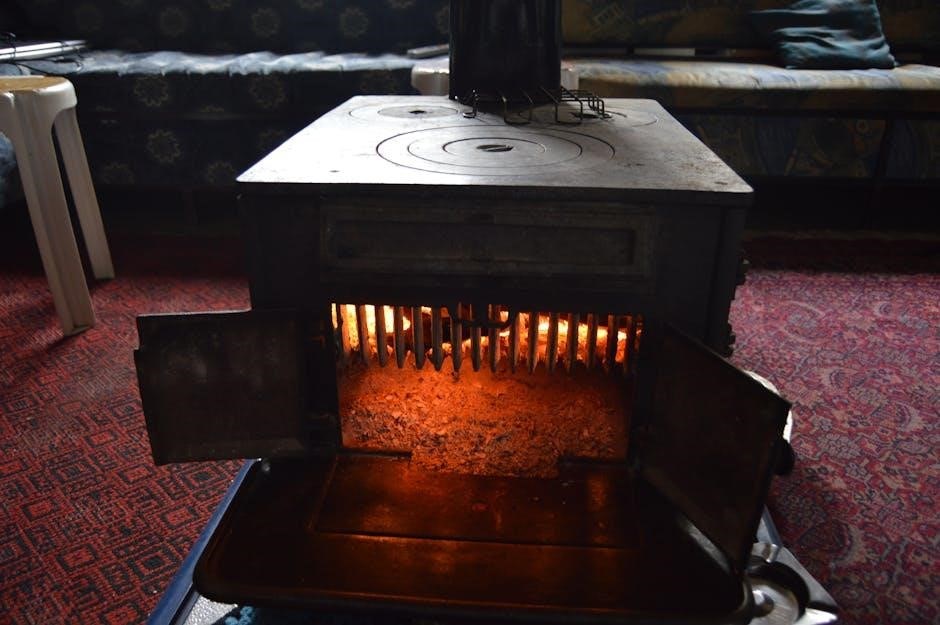
Operating Instructions
Fuel heater with 1-K kerosene, ensure proper ventilation, follow manual for ignition, monitor heat output, and keep area clear for safe operation always.
Fueling the Heater
Always use 1-K kerosene or No. 1 fuel oil, as other fuels can damage the heater. Fill the tank outdoors, away from open flames or sparks. Ensure the heater is cool before fueling. Never overfill the tank, leaving space for expansion. Replace the fuel cap securely after filling. Store leftover kerosene in an approved container, out of reach of children. Avoid using old or stored fuel, as it may degrade and cause issues. Follow the manual’s guidelines for proper fueling to ensure safe and efficient operation.
Ignition and Starting the Heater
Ignition and Starting the Heater
Ensure the heater is on a level, stable surface and properly ventilated. Turn the control knob to the “Start” position and press the ignition button. Hold until the burner lights. Let it run on low for 5 minutes to allow the wick to saturate. Adjust the wick height as needed for optimal flame. Never ignite the heater near flammable materials. If the heater doesn’t light, refer to the troubleshooting section. Always follow the manual’s ignition instructions to ensure safe and efficient operation.
Adjusting the Wick for Optimal Heat
Turn off the heater and allow it to cool before adjusting the wick. Locate the wick adjustment knob, typically found below the burner. Turn the knob clockwise to lower the wick for a smaller flame or counterclockwise to raise it for a larger flame. Ensure the flame is blue and steady for efficient heating. Avoid excessive wick height, as it may cause uneven burning. Always refer to your manual for specific wick adjustment guidelines. Proper adjustment ensures safety, efficiency, and longevity of your Dura Heat kerosene heater.
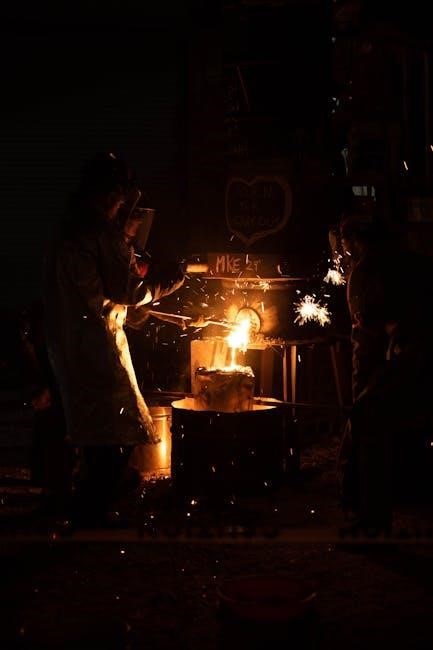
Maintenance and Care
Regular maintenance ensures optimal performance and safety. Clean the heater and burner after each use, inspect for damage, and store properly during off-season. Ensure efficiency and longevity.
Cleaning the Heater and Burner
Cleaning is crucial for maintaining efficiency and safety. Turn off and let the heater cool completely before cleaning. Use a soft brush or cloth to remove soot and debris from the burner and surrounding areas. Avoid using abrasive materials that could damage surfaces. Regularly inspect and clean the wick holder and fuel tank to prevent clogs. Never use water or harsh chemicals, as they can damage the heater. Proper cleaning ensures consistent performance and reduces the risk of malfunction or fire hazards. Refer to the manual for detailed cleaning instructions specific to your model.
Replacing the Wick
Replacing the wick is essential for maintaining optimal heat output and safety. Always turn off the heater and allow it to cool completely before starting. Remove the old wick by gently pulling it out from the burner assembly. Inspect the area for any debris and clean if necessary. Insert the new wick, ensuring it is seated properly and aligned correctly. Use only genuine replacement wicks to avoid damage or performance issues. After installation, follow the manual’s instructions for priming the wick before use. Regular wick replacement ensures consistent performance and extends the heater’s lifespan.
Storing the Heater During Off-Season
Proper storage is crucial to maintain your Dura Heat kerosene heater’s performance and longevity. Before storing, ensure the heater is completely cool. Drain the fuel tank and store the kerosene separately in an approved container. Clean the heater thoroughly, removing any dirt or debris. Cover the heater with a protective storage cover to prevent dust accumulation. Store the unit in a dry, well-ventilated area away from flammable materials. Avoid leaving fuel in the tank for extended periods, as it can degrade and damage the system. Proper storage ensures the heater remains ready for safe and efficient use next season.

Troubleshooting Common Issues
This section helps diagnose and resolve common issues like ignition problems, uneven heat output, or fuel-related malfunctions. Refer to the manual for detailed solutions and safety tips.
Heater Not Igniting
If the heater fails to ignite, check the fuel tank for sufficient 1-K kerosene or No. 1 fuel oil. Ensure the wick is clean and properly positioned. Verify ventilation and inspect for blockages. If issues persist, consult the manual for advanced troubleshooting steps or contact a professional.
Uneven or Inconsistent Heat Output
Uneven heat output may occur due to improper wick adjustment or insufficient fuel flow. Ensure the wick is set to the recommended height and clean of debris. Check for blockages in the burner or fuel line. Verify that the heater is on a level surface and well-ventilated. If issues persist, inspect the fuel quality and ensure it’s 1-K kerosene or No. 1 fuel oil. Avoid using old or degraded fuel, as it can affect performance. Refer to the manual for detailed wick adjustment guidelines and troubleshooting steps.
Fuel-Related Problems
Fuel-related issues often stem from using improper or contaminated fuel. Only use 1-K kerosene or No. 1 fuel oil, as specified. Avoid old or degraded fuel, as it can clog the burner or wick. If fuel is contaminated, drain and clean the tank thoroughly. Check for blockages in the fuel line and ensure the fuel cap is secure. If the heater fails to draw fuel, inspect the wick for proper saturation and alignment. Always refer to the manual for correct fueling procedures and maintenance tips to prevent such issues and ensure reliable performance.

Replacement Parts and Accessories
Ensure optimal performance with genuine replacement parts like wicks, fuel tanks, and caps. Additional accessories, such as filters and maintenance kits, enhance efficiency and safety.

Replacement Wick Options
For optimal performance, use genuine replacement wicks designed for your Dura Heat kerosene heater. Popular options include the Kero-World 32225 and Dura Heat DH-145. Ensure compatibility by referencing your heater’s model number in the manual. Using non-genuine wicks may compromise safety and efficiency. Always follow the manufacturer’s guidelines for installation and maintenance. Replace wicks annually or as recommended to maintain consistent heat output and prevent damage. Genuine wicks are available through authorized dealers or online retailers. Proper replacement ensures reliable operation and extends the heater’s lifespan.
Compatible Fuel Tanks and Caps
Ensure your Dura Heat kerosene heater operates efficiently by using compatible fuel tanks and caps. Genuine Dura Heat tanks are designed to fit specific models like the DFA50, DFA80T, and DFA180CV. Always use 1-K kerosene or No. 1 fuel oil for optimal performance. Avoid using old or improper fuel, as it may damage the heater. For compatibility, refer to your heater’s manual or manufacturer guidelines; Properly reinstall fuel caps after refueling to prevent leaks. Genuine parts ensure safety and efficiency, so check authorized dealers for authentic Dura Heat accessories.
Additional Accessories for Efficiency
Enhance your Dura Heat kerosene heater’s performance with genuine accessories. Replacement wicks, such as the Kero-World 32225 or Dura Heat DH-145, ensure consistent heat output. Authentic fuel tanks and caps, like those for models DFA50 or DFA135C, prevent leaks and maintain fuel quality. Consider maintenance kits for cleaning and storing your heater. Surge protectors and ventilation kits can also improve safety and efficiency. Always purchase accessories from authorized dealers to ensure compatibility and avoid damage. These additions help maintain optimal performance and extend the lifespan of your heater. Consult your manual for specific accessory recommendations.
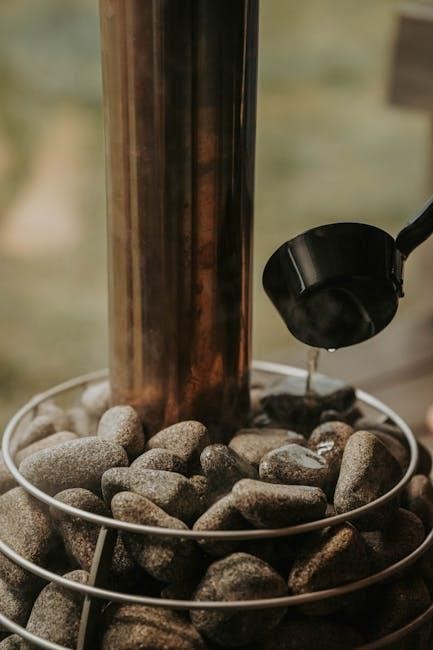
No Responses